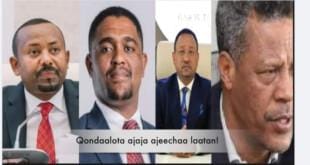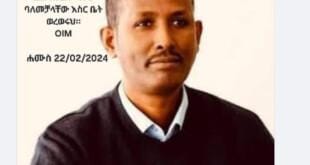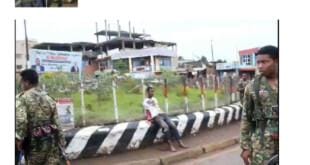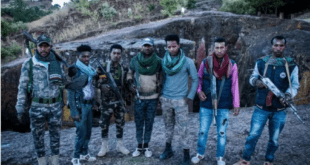By Bekele Anisa, DVM
The purpose of this piece is not to come out with something new about injustices being done to Oromo People as many well known scholars have done and doing better job in their articles on different occasions. The sole objective of this piece is to share with my fellow Oromians what I witnessed when I made a short trip to Oromia 3 years ago because that frightening experience is still haunting me every single night. At this juncture, I appreciate also any feedback and critics if my analysis is bogus, exaggerated, or I am just turning paranoid.
Yes, I have heard, direct or via third party, the ear deafening news from Abyssinians after their visit to Ethiopia, talking about the real progress the country has made. Yes, I witnessed with my eyes the high standing buildings with their eye blinding mirrors in Finfinnee (Addis Ababa) possessed by a few individuals or groups without showing a trickle down effect on the ordinary people, who are skipping a meal or two a day. Yes, my wife and children, including myself, have experienced the vision obscuring, suffocating dark smoke coming out of the exhaust pipe of outdated vehicles on the street of Finfinnee. Since this issue was profoundly addressed by well-qualified oromo scholars, it is not my intention to dwell on it, and I rather go to the topic I decided to put on paper after being in the state of dilemma for 3 years.
Environmental Disaster
I rented a mini bus for round trip to visit my siblings and relatives around Wolliso area, a city 114 km away from Finffine located in western Oromia. While chatting with my wife and children, observing the area through side windows, I was passing by several green houses built to grow flowers on the road to Wolliso. I start thinking what kind of herbicide and pesticide they use to get rid of the weeds and insects. Since the people of Oromia/Ethiopia are not lucky enough to enjoy the luxury of flowers, there is no question about those flowers are loaded to cargo plane to hit the groceries of western Europe and rich Arab states. So, I started also thinking what kinds of preservatives are being used to keep them fresh and succulent. In a country where environmental protection agency is non-existent, I did not have any doubt in my mind those chemicals, whoever the supplier might be, are obsolete to be used in the developed countries. My mind-boggling worries did not stop there. I started also thinking about those educationally deficient my fellow oromians, who are laborers in those green houses without proper personal protective equipment and oblivious to what they are being exposed to, inhaling and absorbing those chemicals via all natural orifices. I kept also thinking about the farm animals grazing grasses contaminated with airborne droplets of those chemicals. As consumer of those farm animals and their products as well as ground water contaminated with residues of those chemicals, the entire society in that area is in jeopardy, even if not directly exposed by working in those green houses. Who knows what health problems the people in the area are already suffering from! Serious side effect on the people’s health in that area can range from cancer, in men and women to infertility, miscarriage, stillborn and handicapped babies in women. Even after TPLF government is dismantled, it takes exorbitant amount of resources to render those green houses to agricultural land, not to mention the residue of those chemicals in the soil, thereby in the ground water, which can take generations to break down, if at all. Even though I am writing what I have witnessed with my very eyes, this practice is ubiquitous in every corner of Oromia. I equate this to gruesome generational genocide.
Cultural Genocide
We continued our journey from Wolliso to the village of not more than 30 households, located 18 km from the city to the north, where I was born and raised. Filled with curiosity and nostalgia, I was paying detail attention to every single noise and landscape through the window. Someone who was born and raised in the rural area might be familiar with what it means to be a child. Every child has to provide the family with some kind of help, what the western would call as a child labor. I turned melancholic and tears filled my eyes by the sight of children herding farm animals while singing at the same time because it reminded me the time of my childhood. But, those songs are not the same as to the ones children of my age and myself was singing during our childhood. It is completely different and they are spiritual songs. I kept on telling myself to be patient until I come across a child singing the same song I used to sing, but in vain. I felt stranger and lost in the village I was born and went to school until 8th grade. By the way, I was there during the time close to Gubaa and Irreecha. In the area I was born, there are two Gubaa ceremonies taking place two days apart. The first ceremony is limited to every single household with young boy/boys of teenage, which is celebrated on the 14th of September in Ethiopian calendar. The second one is celebrated on the 16th of September, which takes place in the proximity of big Oodaa Tree (sacred tree) and all men of different age group in the area are allowed to participate in the ceremony. As excited I was to participate in both ceremonies, I was distracted with anxiety about my children, who had hard time to acclimatize to African hygiene standard and tropical weather. I blame myself for introducing immunologically naive children to harsh African condition at a very young age. My son, who was 2 at the time, succumbed to severe gastroenteritis and was critically ill. If we did not have oral re-hydration solution (ORS) and liquid nutrition (Ensure) we took with us from the US, combined with God’s help, the result would have been very traumatic indelible memory. To go back to the point, I did not care that much when my relatives skipped the first Gubaa, even though I was somewhat perplexed, thinking they got busy because it is not easy to accommodate the need of family of four, who just arrived from America. However, I could not help expressing my disappointment when they skipped the second, majorGubaa. When I calmly asked them what happened to the tradition of our ancestors, they teamed up to explain to me how devilish practice it was. I tried to educate them in oromo tradition/culture,Gubaa symbolizes a profound, heartfelt thanks to the Almighty God (Waaqaa) for a smooth transition from harsh and dark winter to bright spring. They kept on looking at each other with a smile on their faces, and it certainly did not take me time to discern they are laughing because in their opinion I was so gullible. I did not back up also from asking them what happened to the promise we made to our mother, who is looking upon us from heaven right now, not to forget Waaqa Guraacha, as she used to say, it does not matter how decent formal education we acquire and wealthy we become. I emphasized to them that I am still practicing what I promised my mother to do – acknowledging there is a super power, which is Waaqaa Gurracha, praying every single morning, respect for every individual irrespective of his/her academic and financial status, age, gender and creed. Their response was to pray for me for forgiveness for sticking to such backward, primitive and devilish beliefs. I decided to control my temper because I came to the conclusion my relatives were so brainwashed to the point they even sacrifice their lives for the new religion they took over. There is huge campaign going on so that the entire community disdain and contempt religion of its ancestors and replace it by the modern, in their eyes, Pentecostal one. I found a small corner for privacy, where I shed some tears in memory of my perished parents and lost culture, especially major Gubaa where the elderly gave their blessings to the youths and conducted their prayers for smooth transition from winter to spring, abundant harvest and etc. I was carried away by the memory when people were sitting around the fire, waiting for flowers in age group order – first boys go around handing over flowers to the elderly and newlywed, then the newlywed to the elderly, then all married men have to take flower home for the women (husbands give to wives, kissing them on the cheek). This tells us how modern the oromo society is in every aspect, if its culture was not suppressed and marginalized. All ceremonies of horse races (Garmaama) on the next day of Gubaa and those warm blooded Arabian horses with text book body condition, decorated with hand crafted decorative fabrics and shield (Gaachana), are gone with the wind. This tremendous effort to inculcate new religion in a spongy brain of oromo children and youths, who lack the wisdom to differentiate the good from bad, instead of nurturing them with a good education is well orchestrated by the government. The reason behind is, it does not matter how it affects the purportedly orthodox Christian state, to subdue the current youth movement (Qeerroo Movement), which is spreading in fast pace. I equate this to cultural genocide.
On my way back to Finfinnee a gentle man, who knows all my siblings and relatives very well, politely asked me if he could share the mini bus with us, and I consented to his request without hesitation since we had enough spaces. On our journey I asked him where he is going. After a careful thought he told me he is traveling to Harar to take training to become a Christian preacher. I paused for a minute and started thinking how astonishing it is to have Christian training institute in Harar, where majority of the population is Muslim. On the other hand, it cleared my doubt that the government has its hand in it.
Conclusions
If an Oromo person, who is familiar with the outside world and has a decent education, makes a conscious decision to take over different religion, I do not have a minute problem with it. Nor is it my business to talk about someone’s religion. I am fully aware that some Oromo martyrs decided to pursue that path as a bridge to formal education so as to enlighten the plight of their people in the hands of Abyssinians to the world. They never compromised on the revival and preservation of oromo culture, language and tradition, which define Oromummaa. However, I am vehemently against the brainwashing of our children and youths into new religion as a sole tactic to divert their attention from the intifada. Unless we act swiftly and collectively against the Tigreans campaign, which is spreading like a wildfire, to eradicate Oromumma, the danger facing oromo culture and environment, thereby the Oromo People in general, is real and imminent.
Bekele Anisa, DVM
Practicing Veterinarian in the State of California
Can be reached at bekeleanisa@sbcglobal.net




